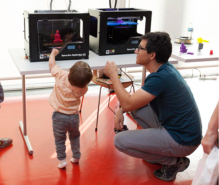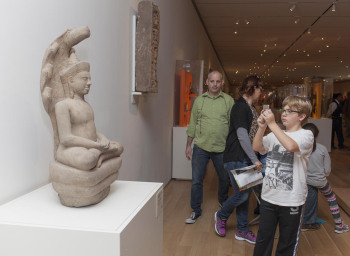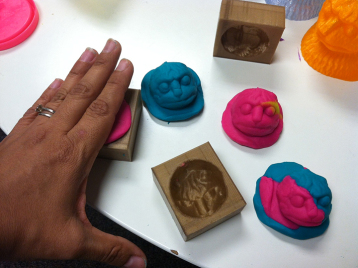On November 9, 2013, we held the 5th annual Diwali Family Festival, initiated to encourage family visits to the Alsdorf gallery of Southeast Asian Art in order to create a deeper, more meaningful engagement with the artwork. This was the first of the Museum3D events. We were very ambitious in our planning,
Family Festivals at the Art Institute provide a wide array of programming to engage a broad intergenerational audience. There is something for everyone. Each year for Diwali we had been offering activities in the museum’s Ryan Education Center such as Southeast Asian dance workshops, making clay lanterns, exploring Ganesha stories through Curious Corner, and floor rangoli, made from torn paper.
Each year the attendance at Diwali has grown, but it has always been a challenge to get families into the galleries on a festival day. We feel that a gallery visit is a key element in making a strong connection with the collection. There are so many things to do in the studios, some families don’t ever make it into the museum. Another challenge is that the museum has an admission fee, whereas the Education Center does not. In the past, we had offered guided gallery tours, a printed self-guide tour booklet, and a drawing station to encourage family gallery visits. We were convinced, however, that the right mix of programs, including 3D scanning and printing, would provide a good “hook” encouraging families to include gallery time as part of their Diwali festival visit, and even making it a priority.
The plan was to offer a 3D scanning activity in one of the Education Center studios which would encourage a family to visit the galleries at it’s conclusion. We would have an educator introduce the idea of posing like a sculpture, direct the family to look at poster reproductions of sculptures on view in the galleries, and encourage the child to pose like his favorite sculpture while atop a large turntable. Then, the family members would work together to move the turntable as the child was being scanned, to create a scan. We used an X Box 360 Kinect to create the scan. (link to a tutorial?)
We hoped that once families had gone through this process, they would become interested in seeing the original artwork and would go to the Alsdorf gallery. Once there, they could create a 3D scan of a sculpture using 123DCatch on an iPad or an iPod Touch, draw a sculpture, or participate in an interactive dance and storytelling session about some of the sculptures.
Diwali, 2013 was much busier than we could ever have anticipated based on past programs. In fact, we attracted almost twice as many people as we had in the previous year. We were concerned that visitors wouldn’t participate in the full process of 3D scanning and printing, and might miss the connections we were trying to make between the education center and gallery activities. We adjusted our strategy throughout the day to accommodate the large numbers of people, in an effort to help encourage deeper engagement with the gallery objects. For example, in the Ryan Education Center we stationed several staff with iPads near the room’s entrance to provide an overview of 3D scanning. These staff showed visitors a 3D scan that had been captured in the galleries earlier in the day, and moved the digital image around as they watched—to show a 360 view. In addition, the staff explained the activities taking place in this room and also encouraged them to visit the Alsdorf gallery scanning station.
In addition, we set up an area where children could create clay sculptures from 3D printed molds made by artist Tom Burtonwood while their parents talked to the artist or while they waited their turn to be scanned. We initially planned to have 5 people staffing the room in the Ryan Education Center, but when we adjusted our plan, we needed 7 people for this one room alone, to effectively work with the crowd.
Throughout the day, families bounced from one activity to another, not necessarily experiencing the activities in the linear sequential order as we had hoped. The idea would have worked better in a workshop format in which an educator guides a small number of families through a series of gallery experiences and art activities.
In the end, however, the 3D scanning and printing room in the Ryan Education Center served 532 people, more than any other single activity that day. In addition, the programs held in the Alsdorf gallery (which included the 3D sculpture scanning activity) accounted for 30% of the total attendance, compared to 15% in the previous year. We felt that we did encourage a much larger percentage of people to visit the galleries than we had in the past. Perhaps that was at least partly due to the inclusion of the 3D scanning and printing activities.
We learned a great deal about the best ways to engage family visitors in 3D scanning and printing through this program, and incorporated those learnings into a subsequent artist-in-residency in which we hosted artist Tom Burtonwood, from late January through mid-August, 2014 and in the planning for the Tween Art Camp, also planned by the Family Programs division of Museum Education.






Leave a Reply